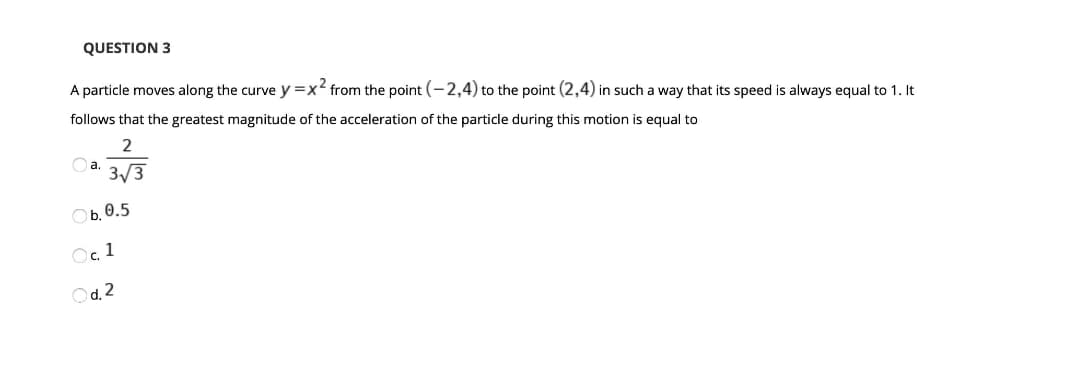QUESTION 3 A particle moves along the curve y=x2 from the point (-2,4) to the point (2,4) in such a way that its speed is always equal to 1. It follows that the greatest magnitude of the acceleration of the particle during this motion is equal to 2 Oa, 3/3 Ob. 0.5 O. 1 Od. 2
QUESTION 3 A particle moves along the curve y=x2 from the point (-2,4) to the point (2,4) in such a way that its speed is always equal to 1. It follows that the greatest magnitude of the acceleration of the particle during this motion is equal to 2 Oa, 3/3 Ob. 0.5 O. 1 Od. 2
Algebra & Trigonometry with Analytic Geometry
13th Edition
ISBN:9781133382119
Author:Swokowski
Publisher:Swokowski
Chapter2: Equations And Inequalities
Section2.7: More On Inequalities
Problem 44E
Related questions
Topic Video
Question

Transcribed Image Text:QUESTION 3
A particle moves along the curve y=x2 from the point (-2,4) to the point (2,4) in such a way that its speed is always equal to 1. It
follows that the greatest magnitude of the acceleration of the particle during this motion is equal to
2
Oa.
3/3
Ob. 0.5
O. 1
Od. 2
Expert Solution
This question has been solved!
Explore an expertly crafted, step-by-step solution for a thorough understanding of key concepts.
Step by step
Solved in 6 steps

Knowledge Booster
Learn more about
Need a deep-dive on the concept behind this application? Look no further. Learn more about this topic, advanced-math and related others by exploring similar questions and additional content below.Recommended textbooks for you

Algebra & Trigonometry with Analytic Geometry
Algebra
ISBN:
9781133382119
Author:
Swokowski
Publisher:
Cengage

Algebra & Trigonometry with Analytic Geometry
Algebra
ISBN:
9781133382119
Author:
Swokowski
Publisher:
Cengage